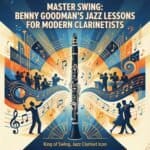On January 16, 1938, Benny Goodman led a landmark jazz performance at Carnegie Hall featuring Teddy Wilson, Lionel Hampton, and Gene Krupa. The concert helped legitimize jazz as concert music in a classical venue and brought swing and the jazz clarinet to a new level of public recognition and respect.
Context: Jazz, Swing, and the United States in the Late 1930s
By late 1937, the swing era was in full force in the United States. Benny Goodman, Duke Ellington, and Count Basie filled ballrooms and radio broadcasts, while labels like Victor and Columbia pushed big band records nationwide. Yet jazz still carried a reputation as dance music, not concert repertoire suited to halls like Carnegie Hall.
Carnegie Hall in New York City symbolized classical prestige. It hosted ensembles such as the New York Philharmonic and soloists like Jascha Heifetz. Presenting a swing orchestra there in 1938 meant challenging social and musical hierarchies. Critics at the New York Times and DownBeat watched closely to see whether jazz could stand beside Beethoven and Brahms.
Racial dynamics also shaped the moment. Segregation remained widespread, and most touring bands were racially uniform. Benny Goodman had already broken ground by hiring African American musicians Teddy Wilson and Lionel Hampton for small group work in 1935 and 1936. Bringing integrated ensembles to Carnegie Hall carried symbolic weight beyond the music itself.
Economically, the United States was still emerging from the Great Depression. Radio, film, and live music offered affordable escape. Goodman's band, propelled by the 1935 Palomar Ballroom breakthrough and hits like “Sing, Sing, Sing,” had become a national phenomenon. The Carnegie Hall concert grew from this mix of popular success and a desire for artistic validation.
The Concert: Date, Venue, Program and Lineup
The Benny Goodman Carnegie Hall concert took place on Sunday, January 16, 1938, at Carnegie Hall in New York City. The program was billed as “An Evening of Modern American Music” and featured the Benny Goodman Orchestra, the Goodman Trio, the Goodman Quartet, and several guest soloists from leading bands of the day.
Carnegie Hall's main auditorium provided a very different acoustic from the ballrooms and theaters Goodman usually played. Instead of dancers, the audience sat and listened, though reports describe frequent applause and shouts. The event was produced by impresario Sol Hurok, who understood both classical and popular markets.
The core Goodman big band included Benny Goodman on clarinet and leader, Harry James and Ziggy Elman on trumpets, Vernon Brown on trombone, and a saxophone section featuring Hymie Shertzer, George Koenig, Art Rollini, and Babe Russin. The rhythm section included Jess Stacy on piano, Allan Reuss on guitar, Harry Goodman on bass, and Gene Krupa on drums.
The small group segments featured the Benny Goodman Trio and Quartet. Pianist Teddy Wilson and drummer Gene Krupa formed the Trio with Goodman. Lionel Hampton joined on vibraphone to create the Quartet. Guest artists included Count Basie sidemen like Buck Clayton and Lester Young, and Ellington trumpeter Cootie Williams, especially featured in the “Jam Session” segment.
The Music: Setlist, Arrangements, and Performance Highlights
The setlist for the Benny Goodman Carnegie Hall concert traced jazz history and showcased contemporary swing. The evening opened with a specially arranged “Don't Be That Way” and included a famous “History of Jazz” medley, small group features, and blockbuster big band numbers like “Sing, Sing, Sing.” Arrangers like Fletcher Henderson and Jimmy Mundy shaped the sound.
The “History of Jazz” segment stitched together tunes such as “Sensation Rag,” “I'm Coming Virginia,” and “When My Baby Smiles at Me.” It moved from New Orleans and Dixieland idioms to Chicago and New York styles. This medley framed jazz as an evolving art form, suitable for a concert narrative rather than just dance entertainment.
One of the most discussed moments is “Honeysuckle Rose” in the jam session section. Here, Goodman shared the spotlight with Lester Young, Buck Clayton, and other Basie players. The relaxed swing feel, conversational solos, and rhythmic looseness contrast with the more tightly arranged big band charts, giving a snapshot of Kansas City style on a New York concert stage.
“Sing, Sing, Sing” closed the concert in spectacular fashion. The performance stretched to more than 12 minutes in the surviving recording, driven by Gene Krupa's tom-heavy drumming and Goodman's clarinet improvisations. Jess Stacy's unexpected, lyrical piano solo, with impressionistic harmonies and subtle touch, became one of the night's legendary surprises.
Other standouts include “One O'Clock Jump” as an homage to Count Basie, and small group pieces like “Body and Soul” and “The Man I Love” that highlighted Teddy Wilson's harmonic sophistication. Across the program, Goodman's clarinet moved from lead voice in ensemble passages to agile soloist, bridging written arrangements and spontaneous improvisation.
Benny Goodman's Clarinet: Instrument, Setup, and Sound (instrument_anatomy)
Benny Goodman played a B-flat Boehm-system clarinet with a medium to large bore typical of professional instruments of the 1930s. The body was grenadilla wood with nickel or silver-plated keywork. This combination produced a focused yet flexible tone that could cut through a big band while still sounding warm in lyrical passages.
The barrel length and internal taper affected response and intonation. Goodman favored a setup that balanced quick articulation with stable pitch in the upper register. A slightly shorter barrel or one with a particular taper can brighten the sound and help high notes speak, which suits his crisp, ringing lead style in charts like “Don't Be That Way.”
Goodman's mouthpiece was relatively close-tipped by modern jazz standards, paired with medium to medium-hard reeds. A closer tip opening with a stronger reed supports precise articulation and a compact, centered tone. It demands strong breath support and embouchure control, which Goodman had developed through rigorous classical and scale practice as a youth in Chicago.
The ligature and reed placement also shaped his sound. A metal or well-fitted fabric ligature that holds the reed evenly encourages quick response. Goodman's clear attacks and clean staccato suggest careful reed alignment, with the reed tip nearly flush with the mouthpiece tip and rails balanced to avoid leaks that cause fuzziness or squeaks.
Keywork ergonomics mattered for his fast passagework. The Boehm system, with its ring keys and plateaued pinky mechanisms, allowed him to execute rapid arpeggios and chromatic runs in solos like those heard on “Avalon” and “Sing, Sing, Sing.” Compared to older Albert system clarinets, the Boehm layout supports smoother finger transitions and more consistent intonation across registers.
For players studying the Carnegie Hall concert, the key takeaway is that Goodman's sound came from a synergy of equipment and technique. A well-made wooden clarinet, a moderately resistant mouthpiece and reed combination, and disciplined breath and finger control produced his bright yet round tone and his famously accurate, singing upper register.
Band Personnel: Profiles of Key Players and Their Roles
The success of the Benny Goodman Carnegie Hall concert depended on a roster of exceptional musicians. Trumpeter Harry James brought dazzling technique and a brilliant upper register, featured in solos on tunes like “Life Goes To A Party.” Ziggy Elman contributed a powerful, extroverted tone and a strong lead presence in the trumpet section.
In the saxophone section, Hymie Shertzer often handled lead alto, providing a tight, polished ensemble sound. Tenor players Art Rollini and Babe Russin added warmth and swing, supporting Goodman's clarinet lines. Their section blend gave the band its characteristic cushion of reeds under the brass and clarinet lead.
The rhythm section anchored the concert. Pianist Jess Stacy balanced rhythmic comping with subtle harmonic color, then stepped into the spotlight with his famous “Sing, Sing, Sing” solo. Guitarist Allan Reuss provided a steady four-to-the-bar pulse, a key ingredient of swing, while Harry Goodman's bass locked in with Gene Krupa's drums.
Krupa's drumming was central to the concert's energy. His tom-driven patterns, press rolls, and showmanship on “Sing, Sing, Sing” electrified the audience. Yet he also played with restraint when needed, supporting small group textures with brushes and lighter cymbal work, especially behind Teddy Wilson and Lionel Hampton.
The small group stars brought their own identities. Teddy Wilson's piano combined stride roots with modern voicings, giving Trio and Quartet numbers a sophisticated harmonic base. Lionel Hampton's vibraphone added a shimmering, percussive melody voice that contrasted with Goodman's clarinet, especially effective on medium-tempo swing tunes.
Guest soloists from Count Basie's and Duke Ellington's bands, including Lester Young and Cootie Williams, expanded the sonic palette. Their appearances in the jam session segments symbolized a meeting of major swing schools: New York, Kansas City, and beyond, all on one prestigious stage.
Contemporary Reception: Reviews, Audience Reaction, and Press
Contemporary reports describe the Benny Goodman Carnegie Hall concert as a major event. The audience included fans, musicians, and critics, filling most of the hall. Applause after solos, shouts during climactic moments, and calls for encores signaled that swing could command attention in a seated concert format.
The New York Times review from January 1938 noted the novelty of a swing band at Carnegie Hall but acknowledged the music's vitality and the crowd's enthusiasm. While some classical critics remained cautious, many recognized that Goodman and his band had achieved something unprecedented for jazz in that venue.
DownBeat magazine and other jazz-oriented publications were more openly celebratory. They highlighted the integration of the ensembles, the presence of stars like Teddy Wilson and Lionel Hampton, and the high level of ensemble precision. The jam session with Basie and Ellington players drew particular praise for its spontaneity.
Audience members later recalled the sense of occasion: formal clothing, a historic hall, and music usually heard in dance settings now presented as something to listen to closely. For younger listeners and musicians, the concert validated their passion for swing as more than passing entertainment.
Some critics did question whether the “History of Jazz” medley oversimplified the music's evolution, or whether big band swing belonged in the same space as symphonic repertoire. Those debates actually underscored the concert's impact, forcing writers and listeners to articulate what jazz meant artistically and socially in 1938.
Recordings, Releases, and Archival Sources (data & references)
The concert was recorded on transcription discs, reportedly as an internal reference rather than for immediate commercial release. These shellac discs captured the full program in real time. For years, the recordings were largely unknown to the public, stored in private or label archives until rediscovery in the 1950s.
In 1950, Columbia Records issued “The Famous 1938 Carnegie Hall Jazz Concert” as a double LP, edited from the original discs. This release introduced a new generation to the performance and quickly became one of the best-selling jazz albums of its era. Later CD and digital editions restored additional material and improved sound quality using modern transfer techniques.
Archival sources include the Carnegie Hall Rose Archives, which preserve original programs, promotional materials, and booking records for the concert. These documents confirm the date, billing, and much of the setlist. Contemporary reviews in the New York Times and DownBeat provide external verification of repertoire and personnel.
Scholars and discographers have cross-referenced matrix numbers, disc labels, and surviving session notes to reconstruct the running order and identify solos. Books on Benny Goodman and swing history often cite these archival materials to clarify discrepancies between memory, marketing, and the actual performance sequence.
Modern listeners can access the concert through official releases on major streaming platforms, CD reissues, and high-quality vinyl pressings. When possible, choose editions that specify use of original transcription discs and include documentation, as these often reflect the most careful restoration and annotation.
How the Concert Changed Public Perception of Jazz and Big Band Music (history_context)
The Benny Goodman Carnegie Hall concert shifted how many Americans viewed jazz and big band music. Presenting a swing orchestra in a hall associated with Brahms and Tchaikovsky suggested that jazz deserved the same serious listening and critical attention as classical repertoire. This move helped open doors for later jazz concerts in major venues.
The event also highlighted jazz as a uniquely American art form. The “History of Jazz” medley framed the music as a national story, rooted in African American creativity and developed across cities like New Orleans, Chicago, and New York. This narrative resonated with a country searching for cultural identity in the late 1930s.
Racial integration onstage carried symbolic power. Seeing Teddy Wilson and Lionel Hampton perform alongside white band members at Carnegie Hall challenged prevailing norms. While the concert did not end segregation, it provided a visible example of integrated artistry at a prestigious address, influencing public perception and younger musicians.
For the music industry, the concert proved that jazz could attract paying audiences in concert settings, not just dance halls. This success encouraged promoters to book other swing and later bebop artists in theaters and concert halls, gradually expanding the spaces where jazz could thrive.
In the longer term, the 1938 concert became a reference point in jazz historiography. Writers and educators often cite it as a milestone that marks the moment when big band swing crossed from popular entertainment into the realm of documented, studied, and canonized art music.
Preserving Instruments and Recordings: Maintenance Best Practices (maintenance_steps)
For clarinetists and collectors interested in swing-era instruments, careful maintenance is important. Vintage wooden clarinets should be kept in stable humidity, roughly 40 to 55 percent, to prevent cracking. Avoid rapid temperature changes, and store the instrument in a hard case when not in use, especially during travel or seasonal shifts.
Regular swabbing after each playing session removes moisture that can damage pads and bore. Use a soft, lint-free swab pulled gently through each section. Apply cork grease sparingly to tenon corks to maintain a snug but not overly tight fit. Inspect pads periodically for leaks or discoloration that signal the need for replacement.
For period keywork, seek a repair technician experienced with vintage clarinets. Springs, posts, and rods may require careful adjustment or replacement with historically sympathetic parts. Avoid aggressive polishing that can remove plating or blur engraving; light cleaning with a soft cloth is usually sufficient for keys and body.
Reed care also matters for achieving a stable, vintage-style tone. Rotate several reeds, allowing each to rest and dry between uses. Store reeds in a ventilated reed case to prevent warping and mold. Light balancing with fine sandpaper or a reed knife can improve response, but work slowly to avoid over-thinning.
Preserving recordings from the era requires archival practices. Original shellac 78s should be stored vertically in acid-free sleeves, away from heat and direct sunlight. Handle discs by the edges and label area only. For tape transfers, keep reels in cool, dry conditions and consider professional baking and digitization if the tape shows signs of deterioration.
Digital files made from historic recordings should be backed up in multiple locations. Use non-compressed or lossless formats for archival masters, with separate compressed copies for everyday listening. Document transfer dates, source details, and any restoration steps so future listeners and researchers can understand the provenance.
Recreating the Sound: Practical Tips and Troubleshooting for Players (troubleshooting)
Modern clarinetists who want to approximate Benny Goodman's Carnegie Hall sound should start with equipment that offers moderate resistance. Choose a well-made wooden B-flat clarinet, a medium-close tip mouthpiece, and reeds in the 3 to 3.5 strength range, adjusting as needed for comfort and control.
To address squeaks, first check reed alignment and condition. The reed tip should be nearly even with the mouthpiece tip, not too far below or above. Make sure the ligature is centered and snug but not overly tight. If squeaks persist, test a slightly softer reed or adjust embouchure pressure to avoid biting.
Unstable altissimo often comes from insufficient air support and finger tension. Practice long tones on high G, A, and B-flat, focusing on steady, fast air and relaxed fingers. Use a tuner to check pitch, and experiment with slight voicing changes by raising or lowering the back of the tongue, as if saying “ee” or “oh.”
If the tone feels too bright or thin compared to Goodman's recordings, try slightly softer reeds or a barrel that mellows the sound. Adjust the embouchure to allow more lower lip cushion and avoid excessive jaw pressure. Long tones at mezzo-forte, aiming for a round, ringing sound, help develop the desired core.
Ensemble balance is critical in big band or combo settings. Listen actively to saxes, trumpets, and rhythm section, and adjust dynamics so the clarinet leads without overpowering. In recording situations, use a microphone placement that captures warmth: slightly off-axis, 12 to 18 inches from the bell and upper joint, rather than directly in the bell.
For articulation, aim for light, fast tonguing with minimal tongue motion. Practice scales and arpeggios in swing eighths at moderate tempos, focusing on evenness and clarity. Transcribing short phrases from the Carnegie Hall concert and playing them slowly with a metronome can reveal details of Goodman's attack and release.
Lessons for Musicians Today: Technique, Career Outcomes, and Legacy (player_outcomes)
Studying the Benny Goodman Carnegie Hall concert offers concrete benefits for modern musicians. Transcribing solos from tracks like “Honeysuckle Rose” or “Sing, Sing, Sing” improves swing phrasing, rhythmic placement, and melodic development. Players learn how Goodman balances written material with improvisation while maintaining a strong narrative arc.
Ensemble listening skills grow by analyzing how the band supports soloists. Notice how the rhythm section adjusts dynamics, how saxes and brass shape backgrounds, and how Goodman cues transitions. Rehearsing with recordings, matching phrasing and dynamics, trains players to respond quickly and musically in group settings.
Clarinetists gain articulation and tone control by emulating Goodman's clarity. Practice exercises include playing scales in all keys with varied articulations, long tones that crescendo and decrescendo smoothly, and interval studies that cross the break cleanly. These technical drills translate directly into more confident performance in jazz and classical contexts.
From a career perspective, the concert illustrates the value of artistic risk. Goodman stepped into a classical hall with dance music and trusted his band, arrangements, and small groups. Modern musicians can draw inspiration to present their work in new venues, collaborate across genres, and document important performances for future audiences.
Historical interpretation is another key outcome. Understanding the social context, racial dynamics, and technological limitations of 1938 helps players make informed choices about tempo, phrasing, and sound. Rather than copying recordings note for note, musicians can honor the spirit of the concert while bringing their own voices to the music.
Key Takeaways
- The 1938 Benny Goodman Carnegie Hall concert marked a turning point in public perception of jazz, presenting swing as serious concert music in a prestigious venue.
- Goodman's clarinet sound combined a well-balanced Boehm-system instrument, a moderately resistant setup, and highly disciplined technique, yielding clarity and projection.
- Archival recordings, programs, and contemporary reviews allow modern listeners and scholars to reconstruct the setlist, personnel, and impact of the performance.
- Clarinetists and bands today can apply lessons from the concert to tone production, ensemble balance, historical interpretation, and creative career planning.
FAQ
What is Benny Goodman Carnegie Hall concert?
The Benny Goodman Carnegie Hall concert refers to a landmark performance on January 16, 1938, when clarinetist and bandleader Benny Goodman presented his swing orchestra, small groups, and guest soloists at Carnegie Hall in New York City. The event helped legitimize jazz as concert music and became one of the most famous jazz concerts in history.
When and where did Benny Goodman play at Carnegie Hall?
Benny Goodman played at Carnegie Hall on Sunday, January 16, 1938. The concert took place in the main auditorium of Carnegie Hall in New York City, a venue traditionally associated with classical music and major orchestras.
Who performed with Benny Goodman at the 1938 concert?
The 1938 concert featured the Benny Goodman Orchestra, the Goodman Trio, and the Goodman Quartet. Key players included Harry James, Ziggy Elman, Jess Stacy, Allan Reuss, Harry Goodman, and Gene Krupa, with Teddy Wilson and Lionel Hampton in the small groups. Guests from Count Basie's and Duke Ellington's bands, including Lester Young and Cootie Williams, also appeared.
Is there a recording of the 1938 Carnegie Hall concert and where can I listen?
Yes. The concert was recorded on transcription discs and later released by Columbia Records as “The Famous 1938 Carnegie Hall Jazz Concert.” It has since appeared on LP, CD, and digital formats. You can hear it on major streaming services and through various CD and vinyl reissues that draw from the original archival recordings.
How did Benny Goodman's clarinet setup contribute to his sound?
Goodman's sound came from a B-flat Boehm-system wooden clarinet, a relatively close-tip mouthpiece, and medium to medium-hard reeds. This moderately resistant setup supported precise articulation, a focused tone, and secure high notes. Combined with strong breath support and refined embouchure, it produced the bright yet warm sound heard at Carnegie Hall.
How can modern clarinetists reproduce Goodman's tone and style?
Modern clarinetists can approximate Goodman's tone by using a quality wooden clarinet, a medium-close mouthpiece, and reeds around strength 3 to 3.5, adjusted for comfort. Focus on steady air, centered embouchure, and clean articulation. Transcribe and practice phrases from the Carnegie Hall recording, paying close attention to swing feel, dynamics, and phrasing rather than only the notes.






